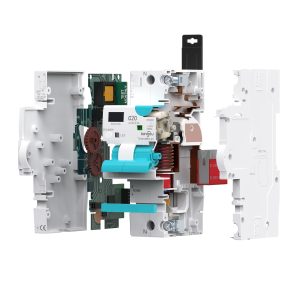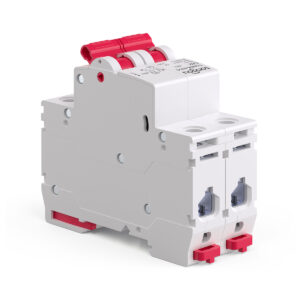
RCBO Trips at Night? Causes, Diagnosis, and Lasting Fixes
RCBO Trips at Night? Causes, Diagnosis, and Lasting Fixes Already know what an RCBO is? Great. This page skips the basics and focuses on nocturnal
Before diving into 4G smart switches, it’s important to understand the foundation — what is 4G LTE, and how does 4G work?
4G LTE stands for “Fourth Generation Long-Term Evolution”, the standard for high-speed mobile communication.
It uses advanced digital radio technology to provide fast, stable, and low-latency data connections through cellular towers.
When you send a message, stream a video, or remotely control a device, your data travels through a 4G LTE network, which converts it into radio waves transmitted to the nearest base station.
These signals then reach the internet backbone, allowing devices to communicate almost instantly from anywhere with coverage.
In short, LTE 4G means faster speed, broader coverage, and lower latency compared to earlier generations like 3G or EDGE.
That’s exactly why engineers began adapting LTE modules not just for phones — but for IoT and smart control systems.

Today, 4G LTE technology isn’t only powering mobile phones — it’s enabling intelligent control systems across homes, industries, and remote environments.
Traditional smart devices depend on WiFi, but WiFi has one major weakness: it needs a stable local network.
Imagine a farm, an offshore station, or a solar-powered cabin — no WiFi routers, no broadband.
That’s where 4G smart switches come in.
These devices use SIM-based 4G connectivity, giving users full control and monitoring ability through the Tuya Smart or Smart Life app, even when there’s no WiFi or wired connection available.
A 4G smart switch is an IoT power controller equipped with a 4G LTE communication module.
Instead of connecting to a router, it sends and receives data through the cellular network — the same network your smartphone uses.
It allows users to:
Turn appliances on/off remotely via mobile app
Monitor real-time voltage and current
Schedule timers or automations
Integrate with voice assistants (Amazon Alexa, Google Home)
Work in 220V EU systems safely
The Tuya EU version integrates seamlessly with the Tuya cloud platform, offering fast response and reliable remote control without WiFi dependence.
To appreciate the 4G revolution, we must first understand the limitations of existing technologies.
Distance Restriction: Wi-Fi signals degrade rapidly through walls and over distance, making it impossible to reliably cover a large property, a detached garage, or outbuildings.
Dependency on Your Router: If your home router reboots, loses power, or you change your password, every Wi-Fi device on your network goes offline.
Gateway Dependency: Zigbee devices require a central Zigbee hub or gateway to function, and they must remain within range of that gateway or another device in the mesh network.
Limited Long-Range Capability: While mesh networking extends range, it is still a “local area” technology, designed for meters, not kilometers.
In essence, Wi-Fi and Zigbee are brilliant for inside the home. But for true, untethered remote control, a new approach is needed.
| Feature | Wi-Fi Smart Switch | Zigbee Smart Switch | TONGOU 4G Smart Switch |
| Control Range | Limited (Tens of meters) | Limited (Meters, extended by mesh) | Unlimited (Global, via mobile network) |
| Dependency | Home Wi-Fi Router | Zigbee Gateway | Independent (Connects directly to cell tower) |
| Best For | Inside the home or office | Dense device networks inside a building | Remote sites, farms, cabins, outbuildings |
| Setup | Pair with Wi-Fi network | Pair with Zigbee gateway | Plug-and-Play (SIM card pre-installed) |
The TO-Q-SY2-JLT works on a fundamentally different principle, much like your smartphone. It doesn’t connect to your home router; it connects directly to a mobile network tower via its built-in 4G module.
This means: If you have a mobile phone signal, your switch is online.
This simple shift delivers three core advantages:
Unlimited Control Range: Control your water pump in rural Bavaria from your office in Berlin. Turn on the heating in your Norwegian cabin while on holiday in Spain. Distance is no longer a factor.
Unmatched Reliability: The switch is completely independent of your home’s internet connection. Even if your home power is out or your router is down, as long as the switch itself has power, it remains online, ready for your command.
Plug-and-Play Deployment: This is the best part. The TO-Q-SY2-JLT comes with a European SIM card already included and activated. There is no complex network pairing, no Wi-Fi passwords to enter, no need to purchase a separate SIM plan. Simply install the device, power it on, and it’s online.
This is where the TO-Q-SY2-JLT truly shines—by solving real-world problems that other technologies can’t touch.
The Problem: A farmer drives several kilometers each day just to turn an irrigation pump or an aerator on and off for a few hours. It’s a daily waste of time and fuel.
The 4G Solution: Install the TO-Q-SY2-JLT in the pump’s control box. Now, from his phone at home, at the market, or on vacation, he can instantly start or stop the pump and set automated schedules, dramatically improving efficiency.

The Problem: A business owner needs to manage power for remote assets like a holiday rental cabin, a mountain-top cellular repeater, or a highway billboard. A simple reboot requires an expensive and time-consuming site visit.
The 4G Solution: When a remote security camera freezes, simply use the app to power cycle the TO-Q-SY2-JLT, performing a hard reboot from anywhere in the world. Easily manage lighting schedules for billboards to save on electricity costs.

The Problem: Critical equipment in unmanned locations—like fish farm aerators, communication room backup fans, or wastewater treatment valves—requires absolutely reliable remote control.
The 4G Solution: The industrial-grade reliability of the TO-Q-SY2-JLT ensures you are always in control when it matters most. Its standard DIN-rail design allows for clean and easy installation into any professional electrical cabinet.

A: No. The TONGOU TO-Q-SY2-JLT is a true smart switch with a SIM card included. It comes with a pre-installed and activated European SIM card, making the setup incredibly simple.
A: Yes. It is equipped with a high-quality 40-Amp relay, making it powerful enough for most agricultural and industrial applications, such as being a smart switch for remote pump control, managing heaters, or controlling motors directly.
A: The device is designed to be flexible. The included European SIM can roam across major 4G, 3G, and even 2G networks. It will automatically connect to the strongest available signal to ensure the most reliable connection for your GSM smart switch commands.

Johnson Lim is the General Manager of Changyou Technology and has over 10 years of experience in circuit protection technology and residential electrical safety. He is committed to developing and producing safer and smarter electrical products.

RCBO Trips at Night? Causes, Diagnosis, and Lasting Fixes Already know what an RCBO is? Great. This page skips the basics and focuses on nocturnal

MCB B/C/D Curves in Practice: How Inrush Current Shapes Your Choice This guide assumes you already know what an MCB is. If you need a

SPD Coordination for Solar PV and EV Charging: Where to Place Type 1/2/3 Already know the difference between Type 1/2/3 and AC vs DC SPDs?

MCB vs MCCB: A Practical Guide to Icu/Ics and IEC 60898 vs 60947-2 This guide assumes you already know what a breaker is. If you

tongou was established in 1993 and is the trademark of Changyou Technology. We position ourselves as providers of intelligent product solutions for high and low voltage electrical systems, taking on solving customers’ pressures and challenges as our responsibility and creating value for them. We utilize intelligent products to serve global customers, making life smarter and more convenient to benefit your life.
Paidong Industrial Zone Qiligang,Yueqing City,Zhejiang province,China.
Sales: [email protected]
After-sales: [email protected]
© 2025 Changyou Technology. All Rights Reserved.

